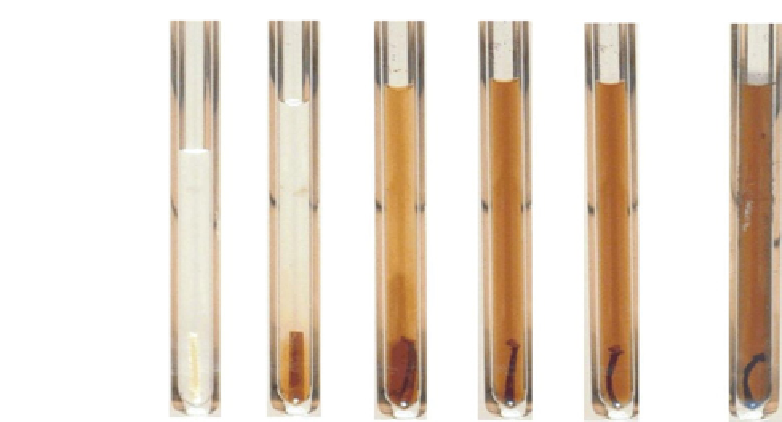Environmental Engineering Reference
In-Depth Information
0
1
2
3
5
30
Time in oven (min)
FIGURE 11.7
Visualization of hydrothermal liquefaction of a wood shred (after 3 min,
the temperature is ca. 340
C and the pressure ca. 150 bar). Figure adapted from
Knezevic (2009).
rectangular wood particle of 1 mm × 1 mm (depth × width), 1500
3000 of such cells
are present. Transport of gases, vapors, and aerosols proceeds predominantly via these
cells in longitudinal direction. Heat transfer into the particle is a multidimensional
process; however, for typical biomass particles with an aspect ratio (length over diam-
eter or width) of three or larger, the dominant heat transfer direction is the diameter
(width). Heat transfer into the particle can be described by the energy balance with the
appropriate boundary conditions for heat transfer to the particle. This equation has to
be solved together with mass balances for biomass, char, and gases/vapors/liquids in
order to give predictions about product yields and conversion time. These parameters
are most important for reactor design. Appendix 11.1 gives the equations of a two-
dimensional single-particle model.
Figure 11.6 (bottom) shows predicted and measured pyrolysis times (time to reach
99% conversion in this case). Clearly, the predictions deviate considerably for small
particles because for these particles the
-
chemical kinetics are dominant in
determining the conversion rate. For these particles, heat transfer to and within the
particles is (much) faster than the chemistry as a result of which the reactions proceed
at the temperature of the surroundings. For larger particles, the predictions become,
more or less, independent of the kinetics because heat transfer inside the particle is the
rate-limiting step. It can also be seen that in this regime the predictions fairly well
match with the measured values. Hence, the properties determining heat transfer such
as density, conductivity, and specific heat and their change during pyrolysis are
known with sufficient accuracy to predict heat penetration. For particles larger than
“
uncertain
”








Search WWH ::

Custom Search